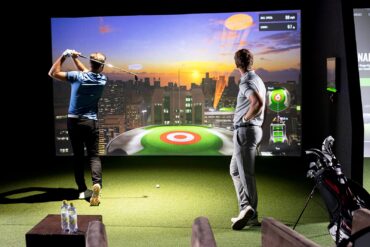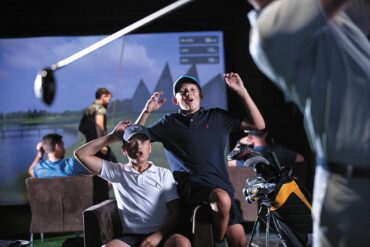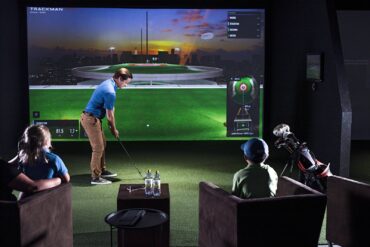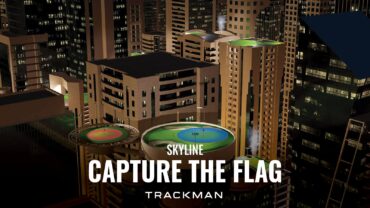
Looking for a great way to revitalize your home? A way to make the time you spend at home more enjoyable? Possibly even increase your home’s resale value? Then consider adding a new, special-purpose room. A special-purpose room is a space dedicated to a specific activity, like a golf simulator room.
In recent years, indoor golf simulator sales have skyrocketed, with industry experts predicting 2024 sales of $2 billion. Many of these sales are to homeowners, and there are a lot of good reasons for this.
These rooms can be the perfect indoor entertainment space for family and friends, according to Ryan O’Keefe, senior director of marketing for Full Swing Golf, a leading simulator manufacturer. He explained that simulators can offer something for everyone. They’re no longer found exclusively in the homes of PGA Tour players and the mansions of the rich and famous. With advancements in technology, almost every homeowner looking to add indoor activities like video gaming, movies on the big screen, televised sporting events, live-streamed exercise classes and golf can afford to add a golf simulator to their home, he says.
 Imagine a room where dad rides his Peloton in the morning, with the instructor leading the class projected on the big screen ahead of him. Later, mom does her yoga routine in that space, with the live stream of the instructor projected on that same screen. And on family night, the whole clan gathers together to watch a movie on the big screen or to play the world-famous St. Andrews golf course in Scotland.
Imagine a room where dad rides his Peloton in the morning, with the instructor leading the class projected on the big screen ahead of him. Later, mom does her yoga routine in that space, with the live stream of the instructor projected on that same screen. And on family night, the whole clan gathers together to watch a movie on the big screen or to play the world-famous St. Andrews golf course in Scotland.
Families love indoor simulators as much as PGA professionals because they’re isolated from the elements, says Tyler Burnett, global marketing manager for Flight Scope, another leading simulator manufacturer. In other words, no matter the time of year, whether it’s 110ºF or minus 10 F, an indoor golf simulator room will provide a comfortable entertainment space for your family and friends.
Choosing a Golf Simulator
As you begin your investigation into golf simulators, here are a few things to keep in mind.
First, not all products provide the same functionality, and you have different options available to you. Golf simulators are the products that provide realistic simulations of playing golf at an actual golf course. These simulations can appear on your laptop or as an image projected on a large screen.
 With more than 30,000 golf courses to choose from, the players take turns teeing off, hitting the golf ball down the fairway and then putting it into the hole. But many of today’s simulators can do much more than just allow you to play golf.
With more than 30,000 golf courses to choose from, the players take turns teeing off, hitting the golf ball down the fairway and then putting it into the hole. But many of today’s simulators can do much more than just allow you to play golf.
Launch monitors are products that track and record the specific elements of hitting a golf ball. Information like the direction the club was heading when it impacted the ball, the angle of the club face at impact, whether at impact you struck the ball with an ascending or descending blow, the distance the ball would have traveled on an actual course, etc. This information is very useful for those looking to improve their performance on the golf course.
Finally, there are the products that perform as both a launch monitor and simulator.
The technology behind these products differs. Some equipment manufacturers use radar to track ball flight information. Others use laser technology. Whichever technology is used, a representation of an environment is created and then projected.
The quality of the images in the environment — things like water, trees, hazards, fairways and greens — can vary from being acceptable to being as life-like as possible. To take advantage of the higher-resolution images, you will need a higher-quality monitor or projector.
 Many simulator manufacturers offer more than one product. Which model you select will often be based on your budget. Typically, the more functionality being offered, the higher the product price.
Many simulator manufacturers offer more than one product. Which model you select will often be based on your budget. Typically, the more functionality being offered, the higher the product price.
But here’s the good news. The industry is making a concerted effort to make simulators available to a larger percentage of the population, so don’t worry about affordability. You can find quality simulators for as little as $600.
Installation Options
Typically, you have three installation options:
1. Do it yourself (DIY), with little or no construction skills required. Expect to spend between $2,000 and $12,000.
Some homeowners choose to purchase and install the simulator themselves. If you’re comfortable using a few hand tools, creating a simple, yet highly functional simulator setup is pretty easy to do. All you need is a computer, the simulator, some tees, a few golf balls, a swath of artificial turf to hit from and a net to hit into.
If your simulator is also a launch monitor, it will will allow you to take the unit with you to the driving range or to the golf course to monitor and record your performance. You will typically find this type of a setup in a garage or in a corner of the home.
 2. DIY, with some construction skills required. Expect to spend between $10,000 and $25,000 for this option.
2. DIY, with some construction skills required. Expect to spend between $10,000 and $25,000 for this option.
If you want to create a space that’s more comfortable, and especially if you want to use the space for more than just practicing golf, then along with the products already mentioned, you will definitely want to purchase and install a high-quality projector and screen. You’ll want to build some cabinetry to hold the screen in place and provide some screen shading from the lighting in the room. You’ll also want to install seating. Lighting modifications may also be necessary in the room.
If you have some construction skills, creating a comfortable indoor space where a few people can relax and enjoy themselves for two to three hours should not be a heavy lift. If you’re looking for design ideas for your room, check out the manufacturers’ websites as well as Pinterest and other online home remodel platforms. You’ll find pictures of beautiful, completely built-out simulator spaces that will give you some design ideas to work with.
3. Hire a professional. Expect to spend between $25,000 and $65,000.
For many, this will be the best option. These are the beautiful rooms you see pictured on the manufacturer websites. The simulator manufacturers can connect you with an experienced contractor in your area, one who is a part of their installer network.
This is the no-stress option because an experienced construction professional is doing all the work for you. Professional installation is the typical solution for most of the more expensive systems.
 Space Requirements
Space Requirements
Most of the manufacturers recommend these minimum space requirements: room height no less than 10 feet, room width no less than 12 feet, room depth no less than 16 feet. If the space you’re considering is less than these recommended dimensions, the simulator manufacturer and your installation contractor can assist you in making the necessary adjustments.
Your simulator room can range from a very simple setup in your garage to an elaborate installation inside your home. A room worthy of a home design feature article with fine-grain wood trim, marble floors, a bar and theater seats. In the past, you may not have considered yourself a big fan of the game of golf, but today’s indoor golf simulators just might change your mind.
A Few of the Golf Simulator Manufacturers
- Full Swing Golf: fullswinggolf.com
- Flightscope: flightscope.com
- Foresight Sports: foresightsports.com
- Trackman: trackman.com
- Rapsodo: rapsodo.com
- GolfZon: golfzongolf.com
- Trugolf: trugolf.com
- SkyTrak: skytrakgolf.com
- About Golf: aboutgolf.com
- Uneekor: uneekor.com
- Bushnell: bushnellgolf.com
- Garmin: garmin.com/en-US/p/695391





























